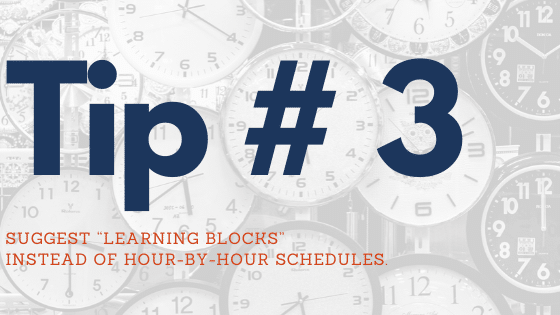
Rethinking the School Day
Schools around the country are rethinking the way they schedule student/teacher engagements in remote learning environments. Whether you’re a campus or district leader designing a master schedule for a team of teachers, you need to think about how you’re going to structure time for your students now that they’re not in a school from bell to bell. Surely, there are important considerations like labor laws, teacher contracts, and other information that must inform the decisions you make in how you structure a remote-school-day. But active time between teacher and student doesn’t need to be the same as it was in the school. You have an opportunity to throw out a lot of the structures that brick and mortar schools use and be much more creative in the way you structure the day.
Here are four tips for rethinking the school day for remote learning.
If you’ve got the flexibility, it’s probably best to throw your normal class roster out the window for these events. Most web conferences start to lose effectiveness with more than 7 or 8 people in them. Any more than that, and students will be less likely to speak up, participate, and interact. It’s far more productive to create blocks of 20 minutes throughout the day, group students for some intentional reason into groups of 5 or 6, and ask them to join when it’s their “group’s” turn then it is to say “3rd period meet me in Google Meets from 9:00-10:00.”

Think of this list of things you WON’T be doing today:
- monitoring bus duty
- monitoring passing periods
- getting kids into the class and into their seats
- passing out materials
- moving kids around the room
- potty breaks
- lunch duty
- attendance
- redirecting that one off-task kiddo while everybody else sits and waits
- collecting materials
Those tasks account for at least an hour or two of the school day.
So, rather than worrying about filling 7 or 8 hours of the day with instructional activity, it’s fair to assume that you should look to fill 5 to 6 hours of the day with instructional content and time for students to complete assignments.Also, consider the fact that some students will have to share devices with siblings and other students in their homes. Of course, if you want to create additional enrichment activity for students, I’m sure every parent and guardian out there will thank you. But if you try and completely replicate the time spent in a school with learning, you’ll drive yourself crazy.
 Instead of thinking about class periods or other long blocks of time, use the normal amount of time a student spends learning in your class each day and divide it into 5, 10, and 20 minute chunks. Of course, all learning time should be divided this way. There’s plenty of research to suggest that any activity longer than 20 minutes has a diminishing return on attention. But there’s an added reason for these shorter chunks of activity. Students are at home, often guided by adults who are also trying to work. If they’re asked to focus on tasks for longer periods of time, these adults will have to do more to actively keep them engaged. For some kids, that’s an unrealistic expectation. If learning tasks can be completed in 5 or 10 minute chunks, students will be apt to see the “light at the end of the tunnel” and keep themselves focused autonomously.
Instead of thinking about class periods or other long blocks of time, use the normal amount of time a student spends learning in your class each day and divide it into 5, 10, and 20 minute chunks. Of course, all learning time should be divided this way. There’s plenty of research to suggest that any activity longer than 20 minutes has a diminishing return on attention. But there’s an added reason for these shorter chunks of activity. Students are at home, often guided by adults who are also trying to work. If they’re asked to focus on tasks for longer periods of time, these adults will have to do more to actively keep them engaged. For some kids, that’s an unrealistic expectation. If learning tasks can be completed in 5 or 10 minute chunks, students will be apt to see the “light at the end of the tunnel” and keep themselves focused autonomously.

Because each household’s schedule will be different, it’s unrealistic to create a schedule for each student that starts at a certain time, is broken down by hour, and then ends at a certain time. Instead, group learning tasks into Learning Blocks of 3 or 4 activities (depending on their length) that make sequential sense and lead to a desired learning outcome.
These Learning Blocks should be some combination of consumption, practice, and demonstration of mastery. The result of every Learning Block must be a learning artifact of some kind. The artifact could be simple, or it could be a component of a larger product due at the end of the week, but Learning Blocks should never just be “read” or “watch” activities. How will you know if students completed them unless they produce something for you.
If you teach a self-contained class, you might create 3 or 4 Learning Blocks a day for students to complete. Of course, things will never go exactly according to plan. So while you might create a “daily schedule,” it’s better to consider the activities you’d like students to complete every two days, and divide learning blocks so that 8 or so blocks are completed by the end of the two-day period.
 Your students will need to interact with you during the day. If possible, a live web-conference (like one facilitated through Zoom, WebEx, Hangouts, Microsoft Teams, or Blackboard Connect) is ideal. But if that just doesn’t work, you could try phone calls, Facetime, or any other number of ways to connect with students.
Your students will need to interact with you during the day. If possible, a live web-conference (like one facilitated through Zoom, WebEx, Hangouts, Microsoft Teams, or Blackboard Connect) is ideal. But if that just doesn’t work, you could try phone calls, Facetime, or any other number of ways to connect with students.
But throwing 30 kids in a Zoom room without a clearly defined purpose is a waste of time. And blocking off 2 hours in the middle of the day for “office hours” will undoubtedly leave someone out. Also, consider that you might not be the only person asking students to connect in a live virtual environment. If every teacher in a high-school setting asks students to spend 30 minutes a day in a webinar with them, students will spend 3-4 hours a day sitting in webinars, leaving little time to actually complete their work. This is where schools and districts will need to step in to coordinate possible times for classes to connect virtually.
But again, only realize the possibility if there’s a reason for students to connect.
If you’re going to use your web-conference time to lecture students or do some kind of direct instruction, stop it. Record your lecture and let students watch on demand. It’s a complete waste of your time and your students time to make them gather together in a Zoom room to listen to you talk. When students gather in a web-conference, it should be for you to hear their voices, not the other way around.
Also, if your school or district “schedules” an hour block for you to connect with students, make sure to create some space in that hour for students to step away from the screen. Again, break the time into 5, 10, or 20 minute segments. Use features like Breakout Rooms, Chat and Q&A so students can work together in groups, learn and share collaboratively, and ask you for help.
If you’ve got the flexibility, it’s probably best to throw your normal class roster out the window for these events. Most web conferences start to lose effectiveness with more than 7 or 8 people in them. Any more than that, and students will be less likely to speak up, participate, and interact. It’s far more productive to create blocks of 20 minutes throughout the day, group students for some intentional reason into groups of 5 or 6, and ask them to join when it’s their “group’s” turn then it is to say “3rd period meet me in Google Meets from 9:00-10:00.”

Structure is important
Students thrive with structure. All of our lives have been thrown into some kind of chaos, so creating some semblance of structure in the day for yourself and your students will be difficult at first, but will pay dividends in the coming weeks and months. So creating Learning Blocks that can be repeated every day or so is a great idea, and has the added benefit of reducing the actual amount of time you have to spend planning lessons. Also, once you find a certain rhythm to your new school day, try and replicate as much of it as possible. This will help normalize remote learning for students and ultimately create the routines they need to thrive.
And don’t forget that, at school, students have everything structured for me–when they eat, bathroom breaks, snack time. Some kiddos won’t have that structure learning from home, so providing students with some guidance on how to manage those tasks throughout the day is a good idea.
Clearly differentiate between must dos and may dos
Most students will receive content from more than one teacher. Unless there’s careful coordination between classes, it’s likely that students and families can quickly get overwhelmed by well-intentioned teachers trying to provide “enough” content to fill the day. It’s always helpful and appreciated to provide families with additional activities to keep students occupied when everyone is cooped up at home together, but some students and parents will overwhelm themselves by trying to get it all done each day, when the teacher had no intention of making everything required. By clearly delineating between enrichment and required activities, you can help reduce the stress of high-achieving students and families who might feel pressure to keep kids current on all they have to do.
Another idea is to create Learning Blocks based on must dos and may dos. Having one or two “optional” activities is a great differentiation strategy, especially for households with multiple students who might work at different paces.
Make time for yourself and your colleagues
If you structure your day so that you have to spend 6 or 7 hours creating content, interacting with students, and reviewing learning artifacts, you’re setting yourself up for failure. Make time throughout the day to connect with your colleagues, share resources and ideas, and co-plan. This is going to be harder than your normal lesson planning, so everything you do will feel like you’re swimming through Jello. Plan on being slower, and plan on spending at least part of your day doing things you didn’t expect (like being tech support for parents and students).

